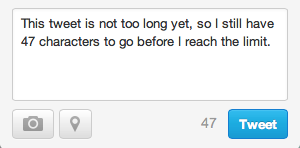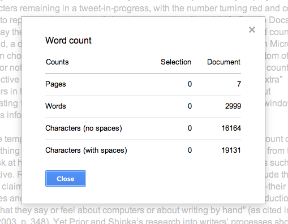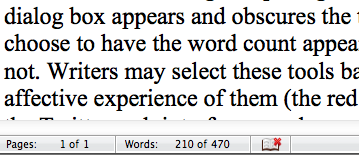Cultural-Historical Activity Theory
Mediated Action
One key insight from CHAT that motivates our work is that all human activity is mediated by tools. These tools can be material, as in the case of hammers, or symbolic, as in the case of language. Further, these tools embody rich cultural histories of development and use, and are embedded in particular times and places. Mediating tools, then, provide a way to ground the analysis of complex activities like writing. Stephen Witte (2005) argued that “activity” is best thought of as a theoretical construct, much like gravity in that “[i]t can be known only through its observable effects or consequences” (p. 142) and is therefore best studied indirectly. In other words, rather than attempting to study “writing” by presuming what does and doesn’t count as part of that activity (should we count notetaking? doodling? generating ideas while gardening or showering?), we instead focus on the tools that mediate writing (pens, paper, genres, software, etc.) and trace the “range of activities and activity systems informing, circulating about, and penetrating the[se] mediational means” (p. 154).
Paul Prior (1998) provides a thorough example of tracing the mediational means involved in the authorship of texts during the course of a research project conducted by sociology faculty and graduate students. He first lists the mediational means involved:
disciplinary and everyday language, genres, and concepts; mathematical systems; computer hardware and software; psychometric and sociometric scales; the nested institutional structures of seminar, research team, department, university, profession, and state; social identities; institutional forums for disciplinary communication (conferences, journals, books); and so on. (p. 180)
He then argues that such a list cannot stand on its own. Instead, “we need to weave tools into specific accounts of writing, to give these silent tools a voice in the constitution of activity” (p. 180). Our project similarly aims to “give voice” to the tools of writing for the same reasons given by Prior, but the data we have collected moves our analysis in a different direction. Instead of “specific accounts of writing,” we analyze the accounts of writing processes created by writers outside of the context of any research project. These accounts are linked by their treatment of a common set of mediational means: distraction-free writing software. These accounts cannot replace the rich level of detail gathered in interviews and observations, but what they do provide is access to a more diverse range of participants and data about the ways writers represent their processes for others (and possibly to themselves).
While the move from a conventional, full-featured word processor (like Microsoft Word or Apple’s Pages) to a minimal, distraction-free text editor is not necessarily as disruptive as the shift from typewriters to word processors, writers making this change are still altering mediational means. Such changes can have a significant effect on people’s activities and goals. James Wertsch (1998) used the example of the introduction of fiberglass poles to the sport of pole vaulting to illustrate the effects of changed mediational means. Several critics of fiberglass poles claimed that, as opposed to bamboo or metal, their flexibility drastically altered the practices of pole vaulting, and that with fiberglass, the spring of the pole did the work rather than the vaulter (pp. 43-44). Although in obvious ways the activity remained the same with the new poles–a person flung themselves over a high bar–in less obvious ways the activity was changed by the new tool and attendant practices as vaulters used the spring of the fiberglass pole to propel themselves higher than previously possible. One former Olympic vaulter compared vaulting with fiberglass poles to circus work, rather than the “sport” practiced with aluminum poles. For this vaulter, the activity has changed drastically (from sport to circus tricks). Similarly, many writers have described the change in focus that they feel when working with distraction-free writing environments. As Wertsch explained, “the introduction of a new mediational means creates a kind of imbalance in the systemic organization of mediated action, an imbalance that sets off changes in other elements such as the agent and changes in mediated action in general” (p. 43).
Such changes in mediated action can result in profound emotional or visceral reactions in participants. The Olympic pole vaulter quit the sport because he found the use of fiberglass poles to be “ridiculous” (Wertsch, 1998, p. 44). Writers, similarly, are notorious for their emotional investments in their tools of choice (e.g., the Lead Pencil Club described in Baron [2000]). As Prior (1998) explains,
Central to appropriation is a person’s affective and evaluative orientation to a tool: Tools may be encountered, partially appropriated, and then rejected. In other words, people develop varied dispositions toward and senses of ownership over the psychological tools they encounter and (to some degree) appropriate. (p. 181)
For some writers, then, appropriating new software for writing is exciting: they enjoy the changes that result in themselves and in the actions and activities such tools afford. They like to tinker with various tools and reflect on the changes that result. Other writers remain attached to tools with which they have become expert and see new tools as disruptive to their carefully honed writing practices. In the next section, we explore the ways that people deliberately coordinate with mediational means to shape and direct their activity and affective states.
Selecting and Structuring Environments
Through their analysis of writing processes (via analysis of texts, writers’ drawings of their processes, and writers’ accounts of their processes and drawings), Prior and Shipka (2003) develop a framework for attending to “the ways writers tune their environments and get in tune with them, the ways they work to build durable and fleeting contexts for their work” (p. 228). They use the term “environment-selecting and -structuring practices,” or ESSP’s, to point to these aspects of writers’ processes. In one example, they show a drawing a writer created to depict a specific episode of writing. The image shows the writer working at a desk and surrounded by a file cabinet and another table. As they explain,
when she engages in a writing process–because writing is very stressful for her–she likes to set up this card table to block off the space as a kind of punishment, so the reward is taking the table down when the writing is finished so that she can move back and forth in that space. (p. 183)
This writer has selected material objects (desk, table, file cabinet) to use in structuring their writing space. More than that, though, Prior and Shipka show how such practices are “meant to regulate thought and affect, to channel attention and action” (p. 228). Like the other writers they describe, who use laundry timers or watch alarms to focus their attention for specific blocks of time, this writer arranges the physical space for writing to create a material incentive for completing the project as well as a visual reminder of the status of the work (i.e., if the table is up, the writing project is not yet done). Further, the table shapes and reflects the writer’s affective relationship to their work: writing is “stressful,” the table serves as a “punishment” for not having the project completed, and the removal of the table is a “reward.” Similarly, they describe one interviewee’s gardening activity “as material, affective, and motivational context-building, creating the conditions that would best serve her tasks of concentrated thought and writing” (p. 223).
As the examples of the table arrangement and gardening begin to suggest, these ESSPs involve not only the moment of inscription itself, but also myriad other activities that shape writing processes. Prior and Shipka’s research looks beyond the particular moments of writing and reading and toward what Prior (1998) has named “literate activity,” which refers to “cultural forms of life saturated with textuality, that is strongly motivated and mediated by texts” (as cited in Prior & Shipka, 2003, p. 237). From this perspective, literate activity is “about the ways we not only come to inhabit made-worlds, but constantly make our worlds–the ways we select from, (re)structure, fiddle with, and transform the material and social worlds we inhabit” (p. 182). These made-worlds, we argue, are both physical and digital and our practices for (re)making these worlds take place online and off.
Where Prior and Shipka largely focus on the selection and structuring of physical environments, we want to suggest that software applications and interfaces can also be selected and structured to tune consciousness in writing activity. As Cynthia Selfe and Richard Selfe (1994) argued in their analysis of early graphical computer interfaces, the designs of software focused on hierarchical displays of information, for example, may tune us toward privileging “rationality and logic” to the exclusion of “other ways of knowing, such as association, intuition, or bricolage” (p. 491). In addition to these ideological influences, software can work to shape and direct consciousness in other ways. Consider the variety of techniques different programs use to display word or character counts. Many Twitter clients prominently display the number of characters remaining in a tweet-in-progress, with the number turning red and counting back up to represent the number of characters over the allotted 140.


Google Docs does not display the word count during composing–when writers invoke the word count command, a dialog box appears and obscures the text. Writers working with Microsoft Word can choose to have the word count appear in the status bar at the bottom of the window or not.


Writers may select these tools based on their goals for word counts and their affective experience of them (the red counter and red highlighting of “extra” characters in the Twitter web interface may be motivating to some writers but exasperating to others), or they may structure the screen or various palette windows to make this information more or less prominent.
It may be tempting to dismiss writers’ efforts to arrange and attend to word count displays as something extraneous to writing activity, or yet another digital distraction from the “real” task at hand. Some research into the role of word processing supports such a perspective. Richard Collier and Clifford Werrier (1995), for example, conclude their study by claiming: “Good writers are good writers, no matter how they write–their processes and their products are only minimally tied to the mode of text production, no matter what they say or feel about computers or about writing by hand” (as cited in Moran, 2003, p. 348). Yet Prior and Shipka’s research into writers’ processes shows us that we should not be so quick to dismiss what writers “say or feel” about their tools or processes. It may be that under the constrained conditions of a study that puts writers in an unfamiliar environment, provides the task and purpose for the writing, and sets time limits, writers produce texts that can be judged as of about the same quality regardless of their feelings or perceptions of their tools. Outside of those constrained conditions, literate activity, and the processes through which people write and engage with texts, cannot be captured in written artifacts alone.
Furthermore, it strikes us as curious that Collier and Werrier dismiss the rich qualitative data they recount when they make their claim that “good writers are good writers” regardless of their tools or feelings. They describe writers who, when forced to use pen and paper rather than computers, manifest their frustration through “audible grunts, groans, and curses” (p. 51), exhibited “resistance [that] … created emotional discomfort” (p. 52), and “crumpl[ed] paper” (p. 54). And yet they readily dismiss these affective responses to working with different tools, as if the only thing that matters is the quality of the final written product. Like Prior and Shipka, we hope to develop frameworks for understanding writers’ processes that incorporate not just evaluation of texts or moments of inscription, but also the sighs of exasperation, the compulsions to download and install numerous writing programs, and the enthusiasm exhibited when everything is arranged “just right.”
In the sections that follow, we examine a variety of distraction-free writing programs and practices. First, we turn to the material design of these programs and the ideological assumptions built into them, exploring how writers engage with these interfaces and their ideologies to “focus” on writing without “distraction.” Then, we shift our attention to a small sample of bloggers who make use of distraction-free software while sometimes resisting that label to explore how writers represent the value of these tools and practices.